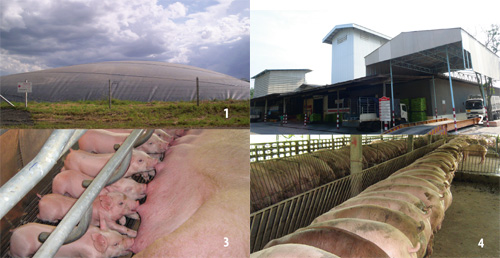RMC Farm: Heavier weaning piglets improve profitability

A good weaning weight can substantially reduce days to market. That in turn improves housing capacity utilisation and saves feed costs at the finishing end, all of which are good for a hog producer’s bottom line, according to Choosak Rattanavanitroj, founder and managing director of RMC Farm.
RMC Farm is located in Burirum province, about 350 km north east of Bangkok, Thailand. The area is a major pig growing area, supplying markets around the city of Nakhon Ratchasima. The farrow-to-finish facility has 5,400 sows and sells about 10,000 head to the market per month. The farm also has a biogas installation linked to an energy generator (see photo 1).
Choosak’s strategy is to stimulate the piglets to eat in small amounts frequently to achieve a heavier weaning weight. Among RMC’s key performance metrics, the most important is that of litter weaning weight which should exceed 79 kg. A heavier weaning weight improves throughput by reducing days to market by up to 15 days, says Choosak. Studies on growth rates in pigs and the effect of birth weights conducted by the Irish Agriculture and Food Development Authority in 2006 confirmed that an increase in birth weight results in a heavier weaning weight and sets the stage for extra bodyweight at slaughter. The study found that each 0.1 kg increase in birth weight results in a 0.2 kg increase in weaning weight. Also, each 0.1 kg increase in the weaning weight leads to an extra 0.5 kg at slaughter.
Feeding
Feeding is an important aspect of RMC’s strategy – and careful planning starts at its own premises. The farm runs an own feed mill (see photo 2) with a capacity of 6,000 metric tonnes/ month. It produces mash feed for internal use. Ideally, RMC targets a weaned piglet body weight of 7.0 kg. However, achieving this goal is often hindered by the tendency of varying weights at birth.
The cost of non-uniformity is substantial and tangible. As a result, RMC prolongs the weaning age slightly to between 23-25 days to get heavier piglets ( see photo 3 ). The average weaning day for the farm in 2010 was 23.3 days.Piglet weaning weight and the amount of feed consumed during the pre-grower period is a good indicator of how well the finishers will perform. In total, the amount of feed eaten during the pre-weaning and pre-starter feed stage should be between 27-29 kg/pig so that the bodyweight of a nine-week-old finishing piglet will be around 27-30 kg. “If you can get them to eat that much, you can predict that the finishing pigs will do well,” says Choosak.
Real story
The numbers tell the real story. If a finisher reaches market weight of 105-107 kg two weeks faster, the amount of feed saved could be as high as 10 kg/pig. Saravud Ratanavanitroj, feed mill manager, says that at five days old, the creep feed is presented as both mash and wet feed at the beginning to entice the young piglets to try it. Little by little, the wet feed is replaced by mash feed. Saravud adds that after weaning, the piglets are given 3 kg of creep feed followed by 8 kg of the pre-starter I diet at a body weight of 8-13 kg. Pre-starter II diet totals 17 kg (BW 13-28 kg). Quality of the feed matters a lot, he says, and the creep feed diet is highly palatable and digestible – see Table 1. Birth-to-finishing takes 23 weeks. Over that period they reach 105-107 kg bodyweight, with ADG of 680-710 g/day, and an FCR of 2.32-2.45.
Breeder operation
Sasana Boonyarith, farm manager, says RMC has worked continuously to improve the genetics of its breeding stock. The sire line is Duroc; the dam line is a cross of Landrace and Large White, using Large White males crossed with Landrace females.
Farrowing rate for breeders is 92% with an average of 11.3 weaned piglets. Weaning to oestrus is five to six days, and over 90% return to oestrus within seven days after weaning. Dry sow feeding is important for good piglet birth numbers, for inclusion rates see Table 1again. Intake during the gestation period gradually increases from 2 kg to 3 kg. Intake is later reduced to 2 kg/day in the last week before parturition and increased again afterwards. Feeding during lactation is 6-7.5 kg/day.
RMC’s goal is to sustain the farrowing rate while trimming the mortality of piglets down along with post-weaning mortality. Currently, culled and pre-weaning mortality is below 6% and weaned-to-market is below 4%. It aims to achieve 28 piglets weaned/sow/year in 2014.
Marketing
The market structure has changed with the growing proliferation of modern trade outlets, Choosak says. Wholesal-ers operating at more than 100 hogs/day are expanding their daily output while smaller processors, running below ten head/day, have decided to buy the most saleable parts from the wholesalers rather than do the killing themselves. Also, some small butchers have expanded their capacity and now sell meat through wholesalers. RMC Farm sells its live animals to traders who slaughter and sell the carcasses to retailers to cut up and sell to users in the end markets.
Choosak is upbeat about the future of the hog industry. It is a business that has a high cost barrier and starting a new farm requires not only knowledge and a hefty capital investment but also a lot of work to convince the surrounding communities that hog farming will not make them worse off environmentally. The industry is becoming increasingly concentrated among fewer and larger farms, and as a consequence is becoming more economically efficient.











